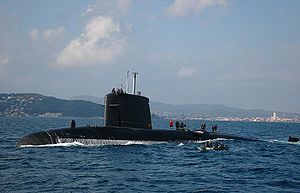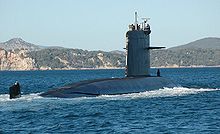Rubis-class submarine
This article needs additional citations for verification. (June 2008) |
 Casabianca in April 2005
| |
| Class overview | |
|---|---|
| Name | Rubis class |
| Builders | DCNS |
| Operators | |
| Preceded by | |
| Succeeded by | Barracuda class |
| Cost | FRF 850 million (1981)[1][2] for the first unit |
| Built | 1976–1990 |
| In service | 1983–present |
| In commission | 23 February 1983 |
| Planned | 8 |
| Completed | 6 |
| Cancelled | 2 |
| Active | 4 |
| Laid up | 1 (Perle - S-606) due to 2020 fire (to be repaired by 2023). |
| Retired | S602 Saphir |
| General characteristics | |
| Type | Nuclear attack submarine |
| Displacement | |
| Length | 73.6 m (241 ft 6 in) |
| Beam | 7.6 m (24 ft 11 in) |
| Draught | 6.4 m (21 ft 0 in) |
| Propulsion |
|
| Speed | 25 knots (46 km/h; 29 mph) |
| Range | Unlimited distance; 20–25 years |
| Test depth | >300 m (980 ft) |
| Complement |
|
| Sensors and processing systems |
|
| Armament |
|
The Rubis class is a series of nuclear-powered attack submarines operated by the French Navy. The class comprises six vessels and they are the most compact nuclear attack submarines to date. All submarines of the class (except for Casabianca) are named after gemstones.
Background and construction[]


Although the Rubis class belonged to the same generation as the Redoutable class, due to President Charles De Gaulle's insistence on acquiring a nuclear deterrent for France, the Rubis program was started only in 1974, after the ballistic missile submarine program. The first Rubis hull was laid down in December 1976 and launched in 1979. The first ship cost 850 million French francs to build.[1][2]
Design[]
They have a central computer system for submarine detection, processing of information, and firing of weapons. The hull is made of 80 HLES high elasticity steel. The sonar dome and sail are made of composite materials. The submarines have two crews, "Blue" and "Red", who man the ships every three months in turn.
AMETHYSTE rebuild[]
The initial design of the Rubis proved to be problematic with unexpectedly high noise levels. This led to the Améthyste silencing program (AMÉlioration Tactique HYdrodynamique Silence Transmission Ecoute, literally Silent Acoustic Transmission Tactical Hydrodynamic Improvement) which was applied to the fifth (S605 Améthyste) and sixth (S606 Perle) hulls.
Améthyste and Perle were both longer that the original Rubis, 73.6 metres (241 ft 6 in) as compared with 72 metres (236 ft 3 in) and the program included upgrades to the sonar, reshaping of the hull form and bow to improve silencing and additional upgrades of the electronics. With the upgrades tested and proven, the original 4 boats were rebuilt to the same standards between 1989 and 1995.

Silhouette before Améthyste rebuild

Silhouette after Améthyste rebuild
They will be succeeded by the second-generation Barracuda class.
Boats[]
| Pennant no. | Name | Laid down | Launched | Commissioned | Decommissioned | Homeport |
|---|---|---|---|---|---|---|
| S601 | Rubis | 11 December 1976 | 7 July 1979 | 23 February 1983 | Toulon | |
| S602 | Saphir | 1 September 1979 | 1 September 1981 | 6 July 1984 | July 2019 | Toulon |
| S603 | Casabianca | 19 September 1981 | 22 December 1984 | 13 May 1987 | Toulon | |
| S604 | Émeraude | October 1982 | 12 April 1986 | 15 September 1988 | Toulon | |
| S605 | Améthyste | 31 October 1983 | 14 May 1988 | 3 March 1992 | Toulon | |
| S606 | Perle | 22 March 1987 | 22 September 1990 | 7 July 1993 | Toulon |
Operational history[]

On 20 August 1993, Rubis collided with the oil tanker Lyria.[4] On 30 March 1994, Émeraude had a steam leakage, suffering 10 casualties.
During the Péan inter-allied manoeuvres of 1998, Casabianca managed to "sink" the aircraft carrier USS Dwight D. Eisenhower and the Ticonderoga-class cruiser that was escorting her.[5]
During COMPTUEX 2015, an exercise led by the US Navy, Saphir successfully defeated the aircraft carrier USS Theodore Roosevelt and her escort, managing to "sink" the US carrier. This was widely advertised by the French Navy but unmentioned by the US Navy.[6][7]
On 12 June 2020, Perle caught fire in dry dock while undergoing major renovations. The fire broke out around 10:35 local time in the forward section of the submarine and was described as being "unbelievably fierce". According to French naval sources, there were no weapons or nuclear fuel aboard at the time.[8] In October 2020 it was announced that Perle would be repaired using the forward section of the decommissioned boat, Saphir. The repairs were projected to be completed in 2023.[9]
Proposed Canada class[]
In 1987, the Canadian White Paper on Defence recommended the purchase of 10 to 12 Rubis or Trafalgar-class submarines under technology transfer, which would be known as the Canada class.[10] with the choice of the type of submarine due to be confirmed before Summer 1988.[11] The goal was to build up a three-ocean navy and to assert Canadian sovereignty over Arctic waters.[12]
The Rubis class as designed failed to meet the Canadian Statement of Requirement (SOR) as it was noisy underwater and slow. It also came with the caveat that the first 4–5 submarines would have to be built in France. Unlike the British Trafalgar class, the Rubis design did not require United States permission to transfer the nuclear propulsion technology, as the Americans were certain to invoke their veto of the sale to Canada. The French brought back a revision to their design, added an "ice pick" so the submarine could operate under ice and were developing a modification for their torpedo tubes which were too short to use the Mark 48 torpedoes.[13] The purchase was finally abandoned in April 1989 due to opposition to nuclear submarines, high costs, particularly with the end of the Cold War.[14][15]
See also[]
- List of submarines of France
- List of submarine classes in service
- Submarine forces (France)
- Future of the French Navy
- Cruise missile submarine
References[]
- ^ Jump up to: a b "First nuclear attack submarine to enter service more than four months late". Le Monde. Retrieved 9 January 2021.
- ^ Jump up to: a b Geistdoerfer, Alice (June 1997). "Des Sous-Mariniers "Un Corps D'Elite" de la Marine nationale française" (PDF) (in French). Mission du patrimoine ethnologique Ministère de la Culture. Retrieved 15 June 2021.
- ^ "SSN Rubis Amethyste Class, France". naval-technology.com. Archived from the original on 8 December 2014. Retrieved 22 November 2014.
- ^ Simons, Marlis (August 1993). "Oil Spills as Nuclear Sub Hits a Tanker Off France". The New York Times. Retrieved 2008-06-14.
- ^ "Sous-marin nucléaire d'attaque Casabianca" (in French). netmarine.net. 2012. Archived from the original on 10 March 2015. Retrieved 22 November 2014.
- ^ Lagneau, Laurent (4 March 2015). "Un sous-marin nucléaire d'attaque français a fictivement coulé le porte-avions USS Theodore Roosevelt". opex360.com (in French). Archived from the original on 9 May 2015. Retrieved 18 May 2015.
- ^ "In 2015, a 30 Year Old French Nuclear Submarine 'Sank' a U.S. Aircraft Carrier". The National Interest. 21 Dec 2016. Archived from the original on 27 December 2017. Retrieved 11 Jan 2018.
- ^ Mackenzie, Christina (2020-06-16). "French submarine burns in 'unbelievably fierce fire' for 14 hours". Defense News. Retrieved 2020-06-17.
- ^ Vavasseur, Xavier (22 October 2020). "Euronaval: France To Repair Fire-Damaged SSN Perle With Forward Section Of SSN Saphir". Naval News. Retrieved 15 June 2021.
- ^ Challenge and Commitment: A Defence Policy for Canada (PDF). Ottawa: Department of National Defence (Canada). 1987. pp. 52–54. ISBN 0-660-12509-9. Archived (PDF) from the original on 25 July 2013. Retrieved 23 July 2014.
- ^ Defence Update 1988-89 (PDF). Ottawa: Department of National Defence (Canada). 1989. ISBN 0-662-55733-6. Archived (PDF) from the original on 28 July 2013. Retrieved 23 July 2014.
- ^ Spicer, Keith (10 September 2007). "Canada's Arctic claims". Ottawa Citizen. Archived from the original on 27 January 2015. Retrieved 22 November 2014.
- ^ Ferguson, Julie H. (1995). Through a Canadian Periscope: The Story of the Canadian Submarine Service. Toronto: Dundurn Press. pp. 317–318. ISBN 1-55002-217-2.
- ^ German, Tony (1990). The Sea is at Our Gates: The History of the Canadian Navy. Toronto: McClelland & Stewart. p. 324. ISBN 0-7710-3268-4.
- ^ Milner, Marc (2010). Canada's Navy: The First Century (Second ed.). Toronto: University of Toronto Press. p. 294. ISBN 978-0-8020-9604-3.
External links[]
| Wikimedia Commons has media related to Rubis class submarine. |
- Rubis-class submarines
- Submarine classes of the French Navy
- Attack submarines


